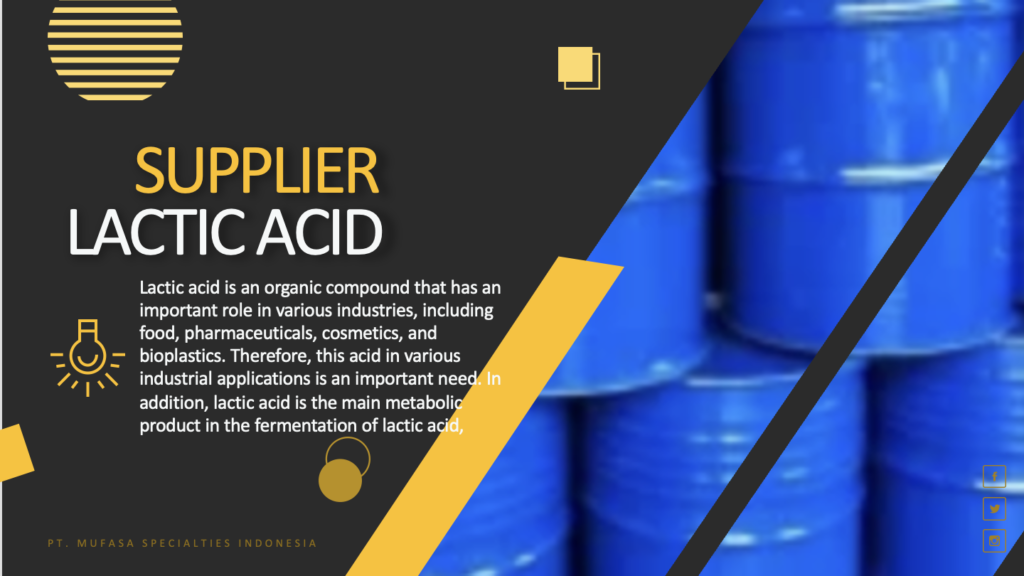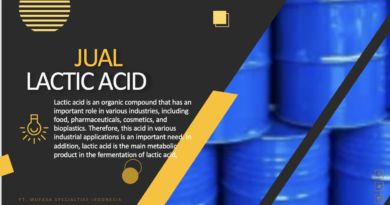
Supplier Lactic Acid
Supplier Lactic acid is an organic compound that plays a crucial role in biotechnological and fermentation processes. It is widely used in food, pharmaceuticals, cosmetics, and biodegradable plastics. Moreover, its production is primarily carried out through microbial fermentation, utilizing various microorganisms such as Lactobacillus, Pediococcus, and Streptococcusspecies. Consequently, this paper explores the biotechnological significance, its fermentation process, production optimization, and industrial applications. In addition, understanding these processes helps in developing cost-effective and sustainable methods.
Biological Pathways of Supplier Lactic Acid
Lactic acid fermentation is a metabolic process wherein sugars like glucose, sucrose, and lactose are converted into lactic-acid. Additionally, the process occurs in anaerobic conditions, making it suitable for microbial growth in oxygen-limited environments. There are two major pathways for fermentation. Notably, each pathway has distinct metabolic steps and by-products.
- Homofermentative Pathway
- Involves lactic α-hydroxypropionic acid bacteria (LAB) like Lactobacillus delbrueckii.
- Produces nearly 90% lactic 2-hydroxypropanoic acid as the sole metabolic product.
- Glycolysis breaks down glucose into pyruvate, which is subsequently reduced via lactate dehydrogenase. Furthermore, this pathway ensures high yield and purity of lactic 2-hydroxypropanoic acid.
- Heterofermentative Pathway
- Carried out by Leuconostoc and Weissella species.
- Produces lactic acid along with other by-products like ethanol, acetic acid, and carbon dioxide.
- Furthermore, the pentose phosphate pathway plays a significant role in glucose metabolism. Therefore, this pathway is less efficient in terms of lactic 2-hydroxypropanoic acid yield but can be useful in mixed fermentation systems.
Microorganisms Involved in Lactic Acid Fermentation
Supplier Lactic acid production largely depends on microbial selection. Therefore, the most commonly used microorganisms include:
-
- Lactobacillus spp. (e.g., Lactobacillus plantarum, Lactobacillus rhamnosus).
- Streptococcus thermophilus.
- Pediococcus acidilactici.
- Enterococcus faecium.
The efficiency of lactic acid fermentation depends on the strain’s acid tolerance, productivity, and ability to utilize diverse carbon sources. Consequently, selecting the right strain is crucial for optimizing yields. Moreover, genetic engineering is being explored to enhance microbial efficiency.
Substrate Utilization and Optimization
Substrate selection plays a critical role in maximizing lactic 2-hydroxypropanoic acid production. Specifically, the most commonly used substrates include:
-
- Carbohydrate Sources: Glucose, sucrose, lactose, starch, and cellulose.
- Renewable Biomass: Agricultural wastes like corn stover, wheat straw, and sugarcane bagasse.
- Synthetic Media: Composed of pure glucose and essential nutrients to support bacterial growth.
Moreover, optimization of fermentation parameters is essential for high yields. Important factors influencing fermentation efficiency include:
-
- pH Control: Ideal pH ranges between 5.5 and 6.5 for most LAB. Additionally, pH adjustments ensure bacterial viability and high conversion efficiency.
- Temperature Regulation: Optimum temperature varies between 30-42°C. Furthermore, deviations from this range can significantly impact productivity.
- Aeration Conditions: Some LAB exhibit enhanced lactic α-hydroxypropionic acid production under microaerophilic conditions. However, strict anaerobic conditions are preferred in certain fermentation setups.
- Nutrient Supplementation: Additionally, the addition of nitrogen sources like yeast extract or peptone enhances cell growth. Furthermore, supplementing with trace elements can improve metabolic activity.
Industrial Production of Lactic α-hydroxypropionic Acid
Supplier Lactic acid production involves fermentation and downstream processing. Typically, the steps include:
-
- Inoculum Preparation: LAB are cultured in a sterile environment before inoculating large fermentation tanks. Moreover, maintaining optimal inoculum density ensures a rapid start to fermentation.
- Fermentation Process: Large bioreactors operate in batch, fed-batch, or continuous mode. In addition, process monitoring is crucial to prevent contamination and ensure maximum yield.
- Product Recovery and Purification:
- Filtration to remove biomass. Furthermore, ultrafiltration enhances the separation process.
- Acid precipitation or ion-exchange chromatography for purification. Additionally, advanced separation techniques like membrane filtration are being explored.
- Crystallization or solvent extraction to obtain high-purity lactic α-hydroxypropionic acid. Moreover, solvent extraction methods are being optimized to minimize losses.
Applications of Lactic α-hydroxypropionic Acid
Lactic acid finds applications in multiple industries due to its biodegradable and biocompatible properties. More specifically, key applications include:
1. Food and Beverage Industry
-
- Used as a preservative and pH regulator in dairy products, meat, and beverages. Furthermore, it improves the microbial stability of food products.
- Enhances flavor and extends shelf-life of fermented foods like yogurt, cheese, and pickles.
- Moreover, it plays a role in probiotic food formulations by supporting gut health.
- Functions as an acidulant in carbonated drinks and confectionery items. Additionally, it helps maintain the consistency of processed foods.
2. Pharmaceutical and Medical Fields
-
- Utilized in drug formulation, controlled-release systems, and topical creams. Furthermore, its compatibility with biological systems makes it ideal for medical applications.
- Serves as a precursor for biodegradable polymers used in sutures and implants.
- Additionally, it contributes to wound healing and tissue regeneration due to its biocompatibility.
- Incorporated into drug delivery systems to enhance stability and absorption. Moreover, research is ongoing to explore its use in advanced pharmaceutical formulations.
3. Biodegradable Plastics
Supplier Lactic acid A major component in poly-lactic-acid (PLA), a sustainable alternative to petroleum-based plastics.
-
- Widely used in packaging, disposable cutlery, and biomedical implants. Furthermore, the demand for biodegradable plastics is increasing globally.
- Shows promise in environmental sustainability by reducing plastic pollution. Additionally, it plays a role in circular economy models.
- Furthermore, research is driving the development of high-performance PLA composites for automotive and textile industries.
4. Cosmetic Industry
-
- Acts as an exfoliating agent in skincare products. Moreover, it enhances skin renewal processes.
- Incorporated into anti-aging and moisturizing formulations. Furthermore, its hydrating properties improve skin texture.
- Provides hydration and enhances skin elasticity through biochemical interactions.
- Additionally, it is used in formulations for acne treatment and skin brightening products. In addition, its antibacterial properties help reduce breakouts.
5. Textile and Leather Processing
-
- Used in dyeing, tanning, and fiber processing to improve texture and durability.
- Enhances fabric softness and breathability through controlled acid treatment. Moreover, it provides a sustainable alternative to harsh chemical treatments.
- Moreover, it serves as a biodegradable alternative to traditional chemical processing agents.
- Improves the eco-friendliness of textile production by reducing wastewater toxicity. Furthermore, it contributes to sustainable fashion initiatives.
Future Prospects and Challenges
The future of supplier lactic acid production focuses on:
-
- Genetic Engineering: Metabolic engineering of LAB to enhance yield and productivity. Moreover, synthetic biology approaches are being explored.
- Cost Reduction: Exploring alternative feedstocks such as food waste and lignocellulosic biomass. Additionally, reducing operational costs remains a major focus.
- Sustainability: Development of environmentally friendly production technologies to minimize industrial waste. Furthermore, closed-loop systems are being investigated.
- Enhanced Purification Techniques: Advancement in membrane separation and electro-dialysis for efficient recovery.
- Automation in Fermentation: Furthermore, the integration of smart sensors and AI-based monitoring can optimize process efficiency. Additionally, real-time data analysis can enhance production consistency.
- Bio-based Innovations: Emerging applications in biofuels and nanotechnology using lactic α-hydroxypropionic acid derivatives. Moreover, collaborations between academia and industry are fostering innovation.
PT. Mufasa Specialties Indonesia is Reliable Supplier Lactic Acid with High Quality Product and Good Price. We are Serving and Delivered Area such Jakarta Bandung Semarang Jogja Surabaya Medan and Batam
Lactic α-hydroxypropionic acid plays an essential role in biotechnology and fermentation industries. Furthermore, its microbial fermentation process ensures sustainable production, making it a valuable compound in various sectors. With advancements in genetic engineering, process optimization, and substrate utilization, production poise for significant industrial growth. Additionally, research efforts continue to improve efficiency and cost-effectiveness. Moreover, continued innovation will be key to unlocking new applications and ensuring a sustainable supply chain for lactic acid-based products.
